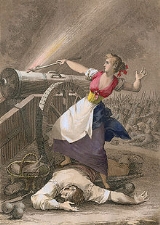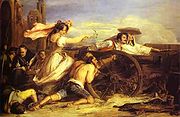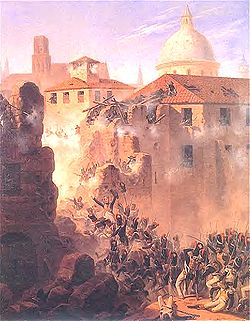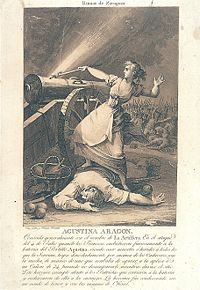
Agustina de Aragón
Encyclopedia
Agustina Raimunda María Saragossa Doménech, or Agustina de Aragón (March 4, 1786 – May 29, 1857) was a Spanish
heroine who defended Spain during the Spanish War of Independence, first as a civilian and later as a professional officer in the Spanish Army
. Known as "the Spanish Joan of Arc
," she has been the subject of much folklore
, mythology, and artwork
, including sketches by Francisco de Goya and the poetry of Lord Byron.
 In the summer of 1808, Zaragoza
In the summer of 1808, Zaragoza
was one of the last cities in northern Spain not to have fallen to the forces of Napoleon
and was therefore, by the time of the siege
, choked with vast numbers of refugee
s fleeing the advancing Grande Armée. In early June, the French began to advance on Zaragoza, which had not seen war for about 450 years and was held by a tiny provincial force under José de Palafox
, whose heroism would come to rival Agustina's.
 On June 15, 1808, the French army stormed the Portillo
On June 15, 1808, the French army stormed the Portillo
, an ancient gateway into the city defended by a hodgepodge battery of old cannon
s and a heavily outnumbered volunteer unit. Agustina, arriving on the ramparts with a basket of apples to feed the gunners, watched the nearby defenders fall to French bayonets. The Spanish troops broke ranks, having suffered heavy casualties, and abandoned their posts. With the French troops a few yards away, Agustina herself ran forward, loaded a cannon, and lit the fuse
, shredding a wave of attackers at point blank range.
The sight of a lone woman bravely manning the cannons inspired the fleeing Spanish troops and other volunteers to return and assist her. After a bloody struggle, the French gave up the assault on Zaragosa and abandoned their siege for a few short weeks before returning to fight their way into the city, house-by-house. With the human cost proving truly terrible on both sides and the city's defences hopelessly compromised, Palafox finally accepted the inevitable and was forced to surrender the city to the French. Despite the eventual defeat, Agustina's action became an inspiration to those opposing the French and, in latter day, to many feminists.

, but an ordinary girl motivated by war. In the mores of the time, a woman who took on "manly" duties posed a problem. However, as the French-imprisoned King of Spain was considered anointed of God
, the Church declared it the duty of every Spaniard to take up arms against his captors.
Various places claim to be Agustina's birthplace. Most biographies suggest that she was born in Reus
, in Tarragona
, in 1786. At an early age, her family moved to Madrid
. To the annoyance of the Spanish, she showed an independence of mind from an early age and records indicate that she was a persistent nuisance, hanging around the Army barracks
at the age of 13.
Although popular history records that she married for love at the age of 16, the age of her son at his death is disputed, suggesting that she might already have been pregnant at the time of her marriage to an artillery gunner by the name of Joan Roca Vila-Seca. The name of her firstborn child does not appear in the popular record, though a gravestone indicates his name was Eugenio. Although her husband was in the army as the Peninsular War
was breaking out, she abruptly left him to return to the home of her sister in Zaragoza.
 The image of Agustina as the saviour of Zaragoza has, however, also overshadowed her later actions. After being captured, she was imprisoned and saw Eugenio die at the hands of her French guards. She subsequently mounted a daring escape and became a low-level rebel leader for the guerrillero
The image of Agustina as the saviour of Zaragoza has, however, also overshadowed her later actions. After being captured, she was imprisoned and saw Eugenio die at the hands of her French guards. She subsequently mounted a daring escape and became a low-level rebel leader for the guerrillero
s, helping to organise raids and attacks that harassed the French. As the strategic situation deteriorated for the French Army, her role became increasingly orthodox as supplies and training were covertly provided by the Duke of Wellington
.
under the command of Major Cairncross
, who reported directly to Wellington himself. This battle was to see the French Army that had occupied Spain effectively smashed beyond repair and driven out of Spain.
. Until 1870 her remains lay in the Church of Our Lady of the Pillar
until 14 June 1908 when she was moved to the Chapel of the Annunciation in the Church of Our Lady (Nuestra Señora del Portillo).
.jpg) Agustina is the only clearly recognisable figure in The Disasters of War
Agustina is the only clearly recognisable figure in The Disasters of War
by Goya who was himself from the same city.
Lord Byron wrote several highly detailed verses in Childe Harold about Agustina.
Lord Byron is known to have traveled throughout Europe, often turning up in places shortly before the arrival of British troops. Despite considered by most critics as wrong on the grounds that she was already married, "Childe Harold" clearly states that a key reason for running to defend the city by manning the cannons was that Agustina had an illicit lover in the city by the name of Raul and that it was seeing close at hand his mortal wounding in the front line that drove her actions. Despite having supposedly never met Agustina before writing Childe Harold, records show that the two of them did indeed meet afterwards.
Spanish people
The Spanish are citizens of the Kingdom of Spain. Within Spain, there are also a number of vigorous nationalisms and regionalisms, reflecting the country's complex history....
heroine who defended Spain during the Spanish War of Independence, first as a civilian and later as a professional officer in the Spanish Army
Spanish Army
The Spanish Army is the terrestrial army of the Spanish Armed Forces responsible for land-based military operations. It is one of the oldest active armies - dating back to the 15th century.-Introduction:...
. Known as "the Spanish Joan of Arc
Joan of Arc
Saint Joan of Arc, nicknamed "The Maid of Orléans" , is a national heroine of France and a Roman Catholic saint. A peasant girl born in eastern France who claimed divine guidance, she led the French army to several important victories during the Hundred Years' War, which paved the way for the...
," she has been the subject of much folklore
Folklore
Folklore consists of legends, music, oral history, proverbs, jokes, popular beliefs, fairy tales and customs that are the traditions of a culture, subculture, or group. It is also the set of practices through which those expressive genres are shared. The study of folklore is sometimes called...
, mythology, and artwork
Visual arts
The visual arts are art forms that create works which are primarily visual in nature, such as ceramics, drawing, painting, sculpture, printmaking, design, crafts, and often modern visual arts and architecture...
, including sketches by Francisco de Goya and the poetry of Lord Byron.
Siege of Zaragoza

Zaragoza
Zaragoza , also called Saragossa in English, is the capital city of the Zaragoza Province and of the autonomous community of Aragon, Spain...
was one of the last cities in northern Spain not to have fallen to the forces of Napoleon
Napoleon I of France
Napoleon Bonaparte was a French military and political leader during the latter stages of the French Revolution.As Napoleon I, he was Emperor of the French from 1804 to 1815...
and was therefore, by the time of the siege
Siege of Saragossa (1808)
The First Siege of Saragossa was a bloody struggle in the Peninsular War. A French army under General Jean-Antoine Verdier besieged, repeatedly stormed, and was repulsed from the Spanish city of Saragossa over the summer of 1808....
, choked with vast numbers of refugee
Refugee
A refugee is a person who outside her country of origin or habitual residence because she has suffered persecution on account of race, religion, nationality, political opinion, or because she is a member of a persecuted 'social group'. Such a person may be referred to as an 'asylum seeker' until...
s fleeing the advancing Grande Armée. In early June, the French began to advance on Zaragoza, which had not seen war for about 450 years and was held by a tiny provincial force under José de Palafox
José de Palafox y Melzi, Duke of Saragossa
José Rebolledo de Palafox y Melzi, Duke of Saragossa was a Spanish general who fought in the Peninsular War.-Biography:...
, whose heroism would come to rival Agustina's.

Portillo
Portillo may refer to:*Portillo *Portillo de Toledo, Spain*Portillo, Valladolid, Spain*Portillo, Chile*Portillo's Restaurants...
, an ancient gateway into the city defended by a hodgepodge battery of old cannon
Cannon
A cannon is any piece of artillery that uses gunpowder or other usually explosive-based propellents to launch a projectile. Cannon vary in caliber, range, mobility, rate of fire, angle of fire, and firepower; different forms of cannon combine and balance these attributes in varying degrees,...
s and a heavily outnumbered volunteer unit. Agustina, arriving on the ramparts with a basket of apples to feed the gunners, watched the nearby defenders fall to French bayonets. The Spanish troops broke ranks, having suffered heavy casualties, and abandoned their posts. With the French troops a few yards away, Agustina herself ran forward, loaded a cannon, and lit the fuse
Fuse (explosives)
In an explosive, pyrotechnic device or military munition, a fuse is the part of the device that initiates function. In common usage, the word fuse is used indiscriminately...
, shredding a wave of attackers at point blank range.
The sight of a lone woman bravely manning the cannons inspired the fleeing Spanish troops and other volunteers to return and assist her. After a bloody struggle, the French gave up the assault on Zaragosa and abandoned their siege for a few short weeks before returning to fight their way into the city, house-by-house. With the human cost proving truly terrible on both sides and the city's defences hopelessly compromised, Palafox finally accepted the inevitable and was forced to surrender the city to the French. Despite the eventual defeat, Agustina's action became an inspiration to those opposing the French and, in latter day, to many feminists.

Background
Original records on Agustina suggest that she was not fervently patriotic or piousPiety
In spiritual terminology, piety is a virtue that can mean religious devotion, spirituality, or a combination of both. A common element in most conceptions of piety is humility.- Etymology :...
, but an ordinary girl motivated by war. In the mores of the time, a woman who took on "manly" duties posed a problem. However, as the French-imprisoned King of Spain was considered anointed of God
God
God is the English name given to a singular being in theistic and deistic religions who is either the sole deity in monotheism, or a single deity in polytheism....
, the Church declared it the duty of every Spaniard to take up arms against his captors.
Various places claim to be Agustina's birthplace. Most biographies suggest that she was born in Reus
Reus
Reus is the capital of the comarca of Baix Camp, in the province of Tarragona, in Catalonia, Spain. The area has always been an important producer of wines and spirits, and gained continental importance at the time of the Phylloxera plague...
, in Tarragona
Tarragona
Tarragona is a city located in the south of Catalonia on the north-east of Spain, by the Mediterranean. It is the capital of the Spanish province of the same name and the capital of the Catalan comarca Tarragonès. In the medieval and modern times it was the capital of the Vegueria of Tarragona...
, in 1786. At an early age, her family moved to Madrid
Madrid
Madrid is the capital and largest city of Spain. The population of the city is roughly 3.3 million and the entire population of the Madrid metropolitan area is calculated to be 6.271 million. It is the third largest city in the European Union, after London and Berlin, and its metropolitan...
. To the annoyance of the Spanish, she showed an independence of mind from an early age and records indicate that she was a persistent nuisance, hanging around the Army barracks
Barracks
Barracks are specialised buildings for permanent military accommodation; the word may apply to separate housing blocks or to complete complexes. Their main object is to separate soldiers from the civilian population and reinforce discipline, training and esprit de corps. They were sometimes called...
at the age of 13.
Although popular history records that she married for love at the age of 16, the age of her son at his death is disputed, suggesting that she might already have been pregnant at the time of her marriage to an artillery gunner by the name of Joan Roca Vila-Seca. The name of her firstborn child does not appear in the popular record, though a gravestone indicates his name was Eugenio. Although her husband was in the army as the Peninsular War
Peninsular War
The Peninsular War was a war between France and the allied powers of Spain, the United Kingdom, and Portugal for control of the Iberian Peninsula during the Napoleonic Wars. The war began when French and Spanish armies crossed Spain and invaded Portugal in 1807. Then, in 1808, France turned on its...
was breaking out, she abruptly left him to return to the home of her sister in Zaragoza.
A leader in the resistance

Guerrillero
Guerrillero may refer to:*A member of a guerrilla group, see: Guerrilla*Guerrillero a Cuban newspaper...
s, helping to organise raids and attacks that harassed the French. As the strategic situation deteriorated for the French Army, her role became increasingly orthodox as supplies and training were covertly provided by the Duke of Wellington
Arthur Wellesley, 1st Duke of Wellington
Field Marshal Arthur Wellesley, 1st Duke of Wellington, KG, GCB, GCH, PC, FRS , was an Irish-born British soldier and statesman, and one of the leading military and political figures of the 19th century...
.
Battle of Vitoria
Agustina began to fight for the allied forces as Wellington's only female officer and ultimately rose to the rank of Captain. On June 21, 1813, she acted as a front line battery commander at the Battle of VitoriaBattle of Vitoria
At the Battle of Vitoria an allied British, Portuguese, and Spanish army under General the Marquess of Wellington broke the French army under Joseph Bonaparte and Marshal Jean-Baptiste Jourdan near Vitoria in Spain, leading to eventual victory in the Peninsular War.-Background:In July 1812, after...
under the command of Major Cairncross
Cairncross
Cairncross can refer to the following people, and is a common name of Scottish origin:* John Cairncross, a Soviet spy from Glasgow* Elizabeth Cairncross, English educator* Cam Cairncross, Australian baseball player...
, who reported directly to Wellington himself. This battle was to see the French Army that had occupied Spain effectively smashed beyond repair and driven out of Spain.
Later life and death
After the war, she married a doctor and, late in life, she became a familiar sight in Zaragoza as a respectable old lady, wearing medals, who used to go for walks around the Portillo. Agustina de Aragón died at the age of 71 in CeutaCeuta
Ceuta is an autonomous city of Spain and an exclave located on the north coast of North Africa surrounded by Morocco. Separated from the Iberian peninsula by the Strait of Gibraltar, Ceuta lies on the border of the Mediterranean Sea and the Atlantic Ocean. Ceuta along with the other Spanish...
. Until 1870 her remains lay in the Church of Our Lady of the Pillar
Basilica of Our Lady of the Pillar
The Basilica-Cathedral of Our Lady of the Pillar is a Roman Catholic church in the city of Zaragoza, Aragon, Spain. The Basilica venerates Blessed Virgin Mary, under her title Our Lady of the Pillar praised as Mother of the Hispanic Peoples by Pope John Paul II...
until 14 June 1908 when she was moved to the Chapel of the Annunciation in the Church of Our Lady (Nuestra Señora del Portillo).
Goya and Lord Byron
.jpg)
The Disasters of War
The Disasters of War are a series of 8280 prints in the first published edition , for which the last two plates were not available. See "Execution". prints created between 1810 and 1820 by the Spanish painter and printmaker Francisco Goya...
by Goya who was himself from the same city.
Lord Byron wrote several highly detailed verses in Childe Harold about Agustina.
Lord Byron is known to have traveled throughout Europe, often turning up in places shortly before the arrival of British troops. Despite considered by most critics as wrong on the grounds that she was already married, "Childe Harold" clearly states that a key reason for running to defend the city by manning the cannons was that Agustina had an illicit lover in the city by the name of Raul and that it was seeing close at hand his mortal wounding in the front line that drove her actions. Despite having supposedly never met Agustina before writing Childe Harold, records show that the two of them did indeed meet afterwards.

